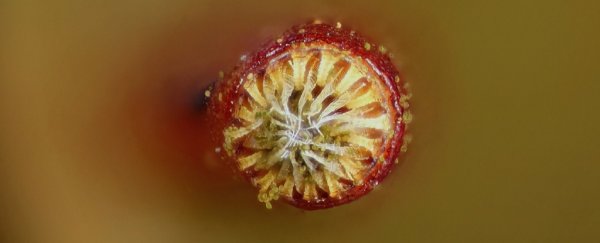The physics behind fungal spore momentum may not keep all of us up at night, but for a select group of scientists, the issue has proved vexing for over a century.
Now, researchers in the US have solved the mystery of how fungi launch their reproductive seedlings, showing how the merging of minuscule water droplets along the surface of fungal gills can provide enough momentum to shoot tiny spores out into the wide blue yonder.
Given the extreme scale involved here – spores only measure about 10 microns (0.01 mm) in width – you might think the whole study basically redefines minutiae, but that doesn't mean these spores aren't in for a wild ride.
"The release of energy is so rapid that it accelerates the entire system with a million Gs, but there's so much air drag that the spore still only travels a few millimetres at most," explains mechanical engineer Chuan-Hua Chen from Duke University.
"That's why it's so important for the spores to shoot directly away from the fungus."
 Duke University
Duke University
The basics of how ballistospores (spores discharged from living beings) are launched has been known for more than a hundred years, after British-Canadian mycologist (fungi biologist) Reginald Buller observed that tiny spheres of fluid forming next to spores were a crucial part of their dispersal.
If these watery spheres – now called Buller's drops – merges with another drop of water on the fungal surface, Buller hypothesised that the merger released enough surface tension energy to eject a nearby spore into the mushroom-height ether.
Now, for the first time, scientists have been able to observe this phenomenon, recreating the mechanism with a spore-shaped polystyrene sphere standing in for an actual spore.
Positioning their proxy on a flat surface, the team coated the stand-in with a mixture of water and ethanol – just enough to make it cling to the surface by itself.
They then used an ink-jet printer to progressively build up a Buller's drop beside their spore, until – in an instant lasting less than a thousandth of a second – the two liquid masses merged.
The extreme speed involved is one of the reasons nobody's ever been able to capture this union in action – but the researchers' super high-speed cameras shot fast enough to document the act.
"[U]nfortunately a microsecond is also the time resolution for most high-speed cameras," Chen says.
"So while researchers made some progress in capturing the overall coalescence process, the detailed mechanism was still not clear."
The new footage reveals that Buller was essentially right in his hypothesis all that time ago. The merged drop exerts friction on the spore, pulling it away from the sterigma – the fungal structures on which spores grow.
This friction in turn pulls the spore away from the surface, launching it clear of the fungus, to be carried wherever the breeze dictates.
None of this would be possible without moisture – but fortunately for balistospheres, the fungal structure means there's not a dry spore in the house.
"There's a point at the top of the sterigma, and it has one of the most poetic names in biology," one of the team, botanist Anne Pringle from the University of Wisconsin, explained to The New York Times.
"It's called the punctum lacryman, which means the point that cries. Something about it, either its texture or its chemistry, means that it accumulates water from the surrounding environment."
While the spore may only travels a few millimetres in the launch process, if the wind catches it there's no telling where it may land, to plant the beginnings of a new, potentially quite gross-to-us fungal home.
Depending on what kind of fungus it is, it could even be something dangerous that we'll want to eradicate.
But at least we now know how it got there.
The findings are reported in Journal of the Royal Society Interface.
